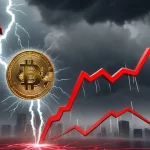Treasury Secretary Bessent’s Pubkey DC Visit Ignites Bitcoin Community Hype

Treasury Secretary Scott Bessent’s Surprise Visit to Bitcoin Bar Sparks Industry Buzz
Treasury Secretary Scott Bessent’s unannounced appearance at the grand opening of Pubkey DC, a Bitcoin-themed bar in Washington, has sent waves of excitement through the Bitcoin community. This unexpected move by a top US official has fueled discussions about Bitcoin’s growing cultural and political clout, even as the market wrestles with a steep price decline from its recent highs.
- Symbolic Breakthrough: Bessent’s visit highlights Bitcoin’s push into mainstream visibility.
- Market Downturn: Bitcoin’s price has fallen to $85,500 from a peak of $125,100, casting a shadow over the hype.
- Policy Potential: Bessent’s pro-crypto track record suggests possible institutional backing for digital assets.
A Toast to Bitcoin: Bessent’s Unexpected Appearance
On a crisp Thursday evening, the doors of Pubkey DC swung open to a crowd of Bitcoin enthusiasts, curious onlookers, and industry insiders. Nestled in the heart of Washington, this new Bitcoin-themed bar—modeled after its popular New York predecessor opened in 2022—was already buzzing with anticipation. But no one expected the night’s biggest surprise: Treasury Secretary Scott Bessent walking through the door, mingling among patrons sporting Satoshi Nakamoto t-shirts and sipping drinks paid for with Lightning Network transactions. For a community often dismissed as niche or rebellious, seeing a figure of Bessent’s stature in such a setting felt like a seismic shift—a middle finger to centralized finance, served with a cold beer. This event has even caught the attention of industry observers, as reported in a detailed piece on Bessent’s surprise visit to Pubkey DC.
Pubkey isn’t just a bar; it’s a cultural outpost for the Bitcoin movement. The New York location gained national attention when Donald Trump made a campaign stop there in September 2024, turning it into a quirky symbol of crypto’s intersection with politics. Pubkey venues host meetups, educational panels, and even accept Bitcoin payments for drinks, fostering grassroots adoption in a tangible way. With Bessent’s visit to the DC branch, the stakes seem elevated, as if Bitcoin is no longer just knocking on the door of power but kicking it down.
Industry leaders couldn’t contain their enthusiasm. Ben Werkman, CIO of Strive, a firm focused on Bitcoin treasury strategies, captured the moment’s weight with a sense of awe:
“Having the Secretary of the Treasury at the Pubkey DC launch seems like a moment I’ll look back on and say, ‘wow, it was all so obvious.’”
Steven Lubka, Vice President of Investor Relations at Nakamoto, was equally bullish, dubbing Bessent’s presence “the sign you have been waiting for.” A chorus of other voices, from analyst Fred Krueger to Gemini executive Jeff Tiller, podcaster Natalie Brunell, and David Zell of the Bitcoin Policy Institute, echoed this sentiment, framing the event as a clear step toward institutional recognition. For Bitcoin maximalists and decentralization advocates, this was a rare moment of validation from the very system they aim to disrupt.
Policy Powerhouse: Bessent’s Crypto Credentials
Scott Bessent, appointed Treasury Secretary in late 2024, isn’t just a random suit showing up for a photo op. He’s built a reputation as a pro-crypto advocate within government circles, a rarity in a landscape often hostile to digital assets. Bessent has vocally supported the GENIUS Act, a proposed bill designed to spur blockchain innovation through tax incentives and regulatory sandboxes—essentially safe zones where startups can test new tech without immediate legal repercussions. He’s also floated the idea of a Strategic Bitcoin Reserve, which would see the US government holding Bitcoin as part of its national assets, much like gold or foreign currency. For the unversed, such a move could position Bitcoin as a geopolitical tool, legitimizing it on a scale most hodlers only dream of.
But let’s not get carried away with rose-tinted glasses. Government involvement in crypto is a double-edged sword. While Bessent’s policies could drive adoption, they also risk inviting overregulation or, worse, centralization of a technology built to escape such control. Imagine a world where Uncle Sam’s Bitcoin stash influences market dynamics—would that undermine the very ethos of decentralization? Playing devil’s advocate, it’s worth asking whether Bitcoiners should cheer a Treasury Secretary’s bar crawl or brace for strings attached to his goodwill. Political wins don’t come cheap, and the road from symbolism to legislation is littered with bureaucratic landmines. Congressional pushback, regulatory red tape, and competing interests could stall even the most promising proposals.
Market Hangover: Bitcoin’s Price Plunge Reality
While the Pubkey DC crowd toasted to Bitcoin’s cultural ascent, the market painted a grimmer picture. Bitcoin’s price has cratered to around $85,500, a gut-punch decline from its all-time high of $125,100 on October 5. That’s nearly a 30% drop in mere weeks, leaving portfolios battered and sentiment fractured. Let’s cut the fluff—photo ops don’t fix price crashes, and anyone claiming Bessent’s visit is an instant game-changer is peddling fairy tales. Some traders remain unimpressed, with one known as MacroScope offering a cold dose of reality:
“In this type of market, signals like this don’t matter much—until later, when everyone realizes they did.”
MacroScope has a point. Crypto markets rarely bend to optics alone; they’re driven by hard math and harsher macroeconomics. So, what’s behind this slide? Analysts point to a macro-driven correction—price drops tied to broader economic headwinds like Federal Reserve rate hikes, persistent inflation, and global uncertainty, rather than a crypto-specific disaster. Unlike past crashes triggered by events like the FTX collapse, there’s no smoking gun here, no scam or implosion to signal a full-blown bear market. Trading volume remains steady, and on-chain activity, a measure of transactions on Bitcoin’s network, hasn’t collapsed, suggesting the bleed isn’t terminal.
Experts like Danny Nelson of Bitwise and Tim Sun of HashKey push this optimistic take further. They argue Bitcoin’s fundamentals are rock-solid, citing metrics like the hash rate—a gauge of network security based on mining power—which continues to hit record highs. Institutional adoption also persists, with corporations like MicroStrategy still stacking Bitcoin on their balance sheets, and payment platforms expanding BTC integration. For seasoned Bitcoiners, this dip is just noise in a long-term signal of growth. Yet, for newcomers, it’s a brutal reminder that volatility is Bitcoin’s middle name. Cultural wins don’t pay the bills when your stack’s underwater.
Cultural Beacons: Pubkey’s Role in Bitcoin’s Rise
Zooming out, Pubkey DC’s opening—amplified by Bessent’s drop-in—underscores how Bitcoin is embedding itself into mainstream society. These bars aren’t mere gimmicks; they’re rallying points for a movement, spaces where the idea of money free from government overreach isn’t just debated but lived. Patrons often pay in Bitcoin via the Lightning Network, a layer-2 solution that enables fast, cheap transactions, proving the tech’s real-world utility. Events at Pubkey locations, from developer meetups to beginner workshops, bridge the gap between crypto’s niche roots and broader public curiosity. When high-profile figures like Trump or Bessent show up, it’s a glaring sign that Bitcoin is no longer a basement hobby—it’s a conversation starter in halls of power.
But let’s not overdose on optimism. Cultural relevance doesn’t equate to price stability or legislative guarantees. For every step toward acceptance, there’s a potential setback lurking—be it a market crash, a regulatory clampdown, or a scandal that taints the space. Bitcoin’s history is a rollercoaster of hype and heartbreak, and no amount of barroom buzz can shield it from that reality. The challenge remains turning these symbolic moments into concrete gains, whether through policy that protects innovation or adoption that outpaces skepticism.
Key Questions for Bitcoin’s Future
- What does Scott Bessent’s visit to Pubkey DC signify for Bitcoin’s mainstream acceptance?
It marks a striking acknowledgment of Bitcoin’s cultural and political relevance, as a top government official engaging with the community signals growing visibility and potential institutional support. - Can Bessent’s pro-crypto stance translate into meaningful US policy changes?
His support for initiatives like the GENIUS Act and a Strategic Bitcoin Reserve hints at a future where Bitcoin integrates into national economic strategies, though political and regulatory obstacles could delay or derail progress. - Is the current Bitcoin price drop a warning sign or a passing storm?
Most analysts see it as a temporary correction driven by macroeconomic factors, not a systemic crypto failure, with strong fundamentals like hash rate and institutional interest suggesting resilience. - Why do some traders downplay symbolic events like Bessent’s visit during market slumps?
With prices in freefall, gestures like these often fail to impact immediate sentiment or value, though they may later be recognized as pivotal moments in Bitcoin’s journey. - How do hubs like Pubkey DC advance Bitcoin’s cause?
They serve as cultural touchstones, drawing attention from influential figures and everyday users alike, while fostering education and adoption to connect Bitcoin’s niche appeal with wider public awareness.
Stepping back, Bessent’s surprise visit to Pubkey DC is a vivid snapshot of Bitcoin in 2024—a defiant technology gaining traction among the powerful, yet still at the mercy of market swings and policy uncertainties. For every shout of “institutional acceptance,” there’s a murmur of caution that the path to legitimacy is fraught with traps. As champions of decentralization and financial sovereignty, we view this as a net positive, a crack in the armor of the status quo. But let’s not sip the hopium straight—Bitcoin’s battle for relevance is far from won. A Treasury Secretary’s bar tab can’t cover the cost of complacency; the real grind lies in securing policies and adoption that match the hype, all while navigating a market that punishes the naive with ruthless precision. Will this barroom buzz spark boardroom breakthroughs, or is it just another fleeting round of cheers?



